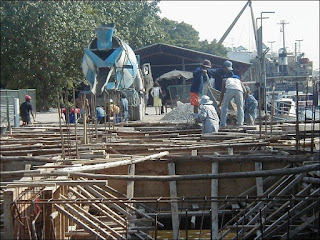The main purpose of RCC is to bear loads that can't be beared by plain concrete or any other construction material at the same price range. RCC structures are designed to bear various types of loads acting on it.
 |
| Image source: Internet |
Types of load acting on RCC structures
Various types of loads which are expected to act on RCC structure are:-
Dead loads of building/structure depends on:-
The unit weight of the commonly used building is shown in IS 875 (part 1st) 1987.
Live load depends upon:-
Wind loads depend on:-
Designing of these structures should be based on adding a new load also called snow load.
For getting detailed information on snow loads refer to IS 875 (Part 4) 1987 which deals with snow load on roof or building.
As per IS: 1983-2002 (Part 1) (General provisions of buildings), India is divided into four seismic zones. The code gives the recommendation for building earthquake-resistant structures and now it is mandatory to follow all these codal recommendations while designing the structure.
For this post
Information given in red colour is important for competitive exams.
- Dead load
- Live load
- Wind load
- Snow load
- Seismic load
1. Dead load:-
Dead load is the self-weight of the structure. These loads are also called permanent loads and can't be removed and decreased. These loads are always present in the structure.Dead loads of building/structure depends on:-
- The material used for the construction of the building.
- Quantity of material used.
- Size of a building structure.
The unit weight of the commonly used building is shown in IS 875 (part 1st) 1987.
2. Live loads:-
Live loads are also known as superimposed loads. These loads consist of loads due to temporarily placed objects like chair, desk, freezer, television, machines, living organisms including humans, etc. These loads change for a structure continuously.Live load depends upon:-
- Use of building
- Type of building
3. Wind loads:-
Flowing air i.e. wind exerts horizontal forces on the structure which are called Wind loads.Wind loads depend on:-
- Velocity of flowing wind
- Shape of building
- Size of building
4. Snow loads:-
These loads are acted on those buildings which are located in those regions where snowfall is very common.Designing of these structures should be based on adding a new load also called snow load.
For getting detailed information on snow loads refer to IS 875 (Part 4) 1987 which deals with snow load on roof or building.
5. Seismic loads:-
Seismic loads also called earthquake loads depend on the location of the building.As per IS: 1983-2002 (Part 1) (General provisions of buildings), India is divided into four seismic zones. The code gives the recommendation for building earthquake-resistant structures and now it is mandatory to follow all these codal recommendations while designing the structure.
For this post
Information given in red colour is important for competitive exams.



